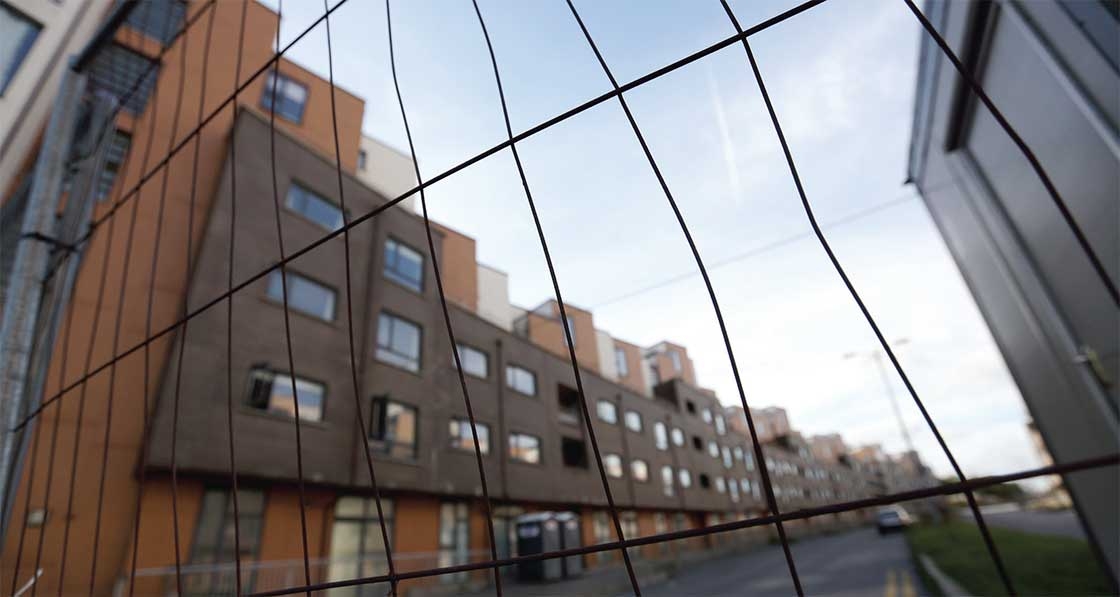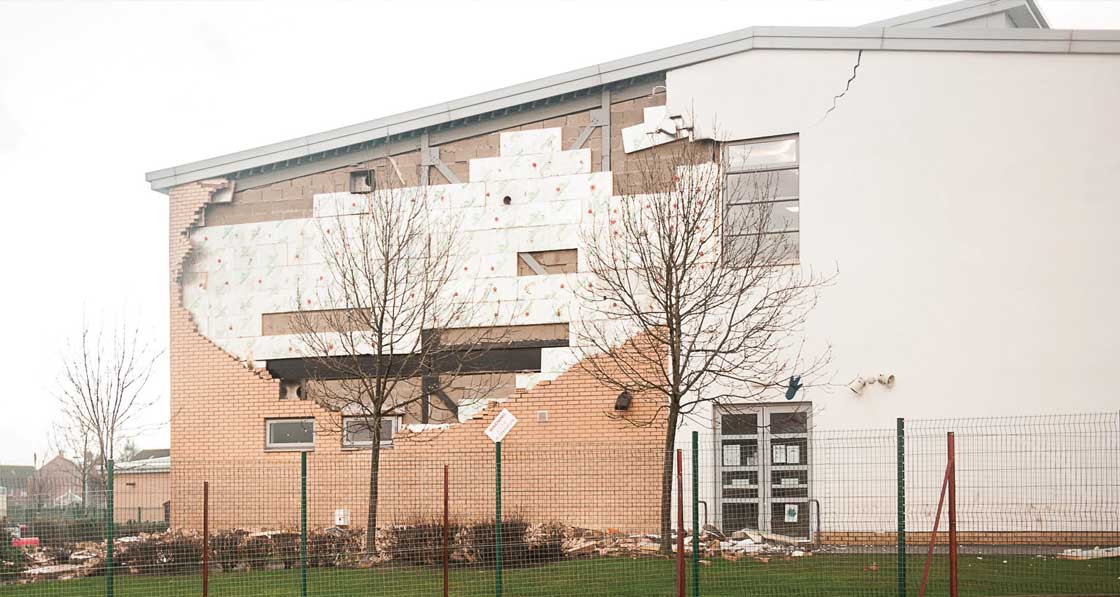
- Dispatches
- Posted
Out of control? Are building control systems properly equipped to deliver safe, healthy and well-constructed buildings?
After a litany of dangerous and high profile building failures in Ireland, many in the country’s building industry looked longingly across the Irish Sea and held up the UK as an example of how to do building control properly. But following a series of embarrassing defects with UK construction projects, it’s clear the British system is far from perfect. So is either of these building control systems properly equipped to deliver safe, healthy and well-constructed buildings?
This article was originally published in issue 20 of Passive House Plus magazine. Want immediate access to all back issues and exclusive extra content? Click here to subscribe for as little as €10, or click here to receive the next issue free of charge
There’s a lot of house building in the pipeline. In the UK, the government has committed to building 200,000 new homes a year during the lifetime of the current parliament. Meanwhile, in Ireland, the government has announced that 30,000 homes in major cities will be ‘fast-tracked’ in the next three to four years, as part of its plan to deal with the ongoing housing crisis. The government’s ‘Rebuilding Ireland’ programme also envisages a doubling of the output of overall housing from the current levels to at least 25,000 per year by 2020.
At the same time, defective buildings are rarely out of the news. A 2015 survey from the Home Builders Association in the UK found that 93% of buyers report problems to their builders, with 35% of those reporting 11 problems or more.
Last April, 17 schools had to be closed in Scotland over safety concerns relating to faulty construction, after the masonry walls of some school buildings fell down in high winds. Meanwhile Orchard Village, a flagship residential development by the Clarion Housing Group in East London, has been plagued by reports of leaks, damp and mould, structural defects, inadequate fire proofing, and lack of insulation. And housebuilder Bovis Homes is now paying £7m to repair the poorly built dwellings it sold to customers.
A recent report by the housing charity Shelter emphatically concluded that England’s housebuilding system is rigged to favour developers and speculators rather than families, and that the system results in high-price, poor quality homes.
In Ireland, developments like Priory Hall, Longboat Quay and Millfield Manor have become bywords for bad building practice. In the latter case, to pick just one, six houses in Millfield Manor burned to the ground in less than half an hour on 31 March 2015. A subsequent report by a fire consultant found ‘life threatening’ defects in other houses in the development.
Meanwhile Balgaddy, a major social housing development built in west Dublin at the height of Ireland’s construction boom, has been plagued by reports of damp, mould and structural defects. And the European Committee of Social Rights, an arm of the Council of Europe, is expected to adjudicate this year on a complaint by residents of 20 Irish local authority housing estates relating to substandard housing.
So if we’re going on a building spree, are there any guarantees about the quality of housing we’re going to get?
In Ireland, Building Control (Amendment) Regulation SI9 was introduced in March 2014 as a response to that challenge. BCar, as it is now known, establishes a paper trail to document all building activity on a project and identify those responsible in the event of a defect occurring. An ‘assigned certifier’ drawn from the ranks of architects, surveyors or engineers is required to sign off on each stage of the build. This person is then theoretically responsible should anything go wrong.
Ensuring good building practice is of course about much more than just building control. It’s a multi-faceted objective, bringing in building regulations, technical guidance, industry skills and oversight. Perhaps the most critical element is whether a culture of compliance exists in the industry in the first place.
In that regard, many within the construction sector will tell you that BCar has, at the very least, heralded the beginnings of a cultural shift. Eoin Leonard is CEO of i3PT Certification, one of the country’s leading assigned certifi cation firms. He points out that since BCar was introduced, there has been enhanced due diligence from design and construction teams.
“Even the harshest critics of BCar would have to admit that the levels of debate, discussion and upskilling in the area of building regulations have been unprecedented,” he says. “So too the sudden adoption of electronic reporting systems, quality management systems and the welcome reintroduction of clerks of works on construction sites.”
He points out that BCar continuing professional development (CPD) sessions tend to be booked out, and that the industry has never been so engaged in this topic. “Liability is very real now. The level of scrutiny applied to technical submittals, benchmarks and site inspection has improved immeasurably.”
Orla Hegarty, assistant professor at the School of Architecture in UCD, agrees that we have seen some positives as a result of BCar. “I would say yes, there has been a change in the culture, we are now seeing some cultural awareness about compliance.”
That said, neither Leonard nor Hegarty believe that the system has gone as far as it could in terms of influencing change and protecting consumers.“It’s still self certification,” says Hegarty. “There’s no independent inspection system. We know from other sectors that there has to be a level of independence in inspections or it doesn’t work. That’s true of any industry, whether it’s food safety or nursing homes or banking.”
Eoin Leonard points out that for the certifier role to work, there has to be impartiality. While many clients and developers can and do hire independent certifiers, they aren’t required to. “As it is, designers or builders can sign-of on their own buildings, and a handful of the country’s largest design firms continue this practice. This would not be deemed permissible in many other countries in the developed world.”
Critics also point to the fact that as far as consumer protection goes, the system is deeply flawed. By assigning liability to a certifier, the impression is given that homeowners will have recourse if things go wrong. But that recourse can only be activated through the courts – making the process expensive, unwieldy and uncertain.
While certifiers are obliged to have public liability insurance, the nature of building work is that defects may not emerge for years, by which time the certifier may have ceased to practice, meaning that his insurance will have lapsed, leaving the consumer with no realistic means of redress.
While the Irish system relies on a wholly privatised system of control, building control in the UK relies on a mix of private sector fi rms and local authority inspectors. Local authority building control officers, or private ‘approved inspectors’, make routine visits to site, ensure the building complies with regs, and issue a compliance certificate on completion.
In England and Wales, all local authority building control departments are members of Local Authority Building Control (LABC) which operates a warrantee scheme that covers homeowners against defects that occur after the first two years. Generally speaking, within that first two year period, the builder is responsible for dealing with any defects that arise.
While many critics of the Irish system defer to the UK system as superior, it is not without its faults. In recent weeks, it has emerged that the National House Building Council (NHBC) – which provides around 80% of the warranties in the UK – pays millions of pounds a year to building contractors. The NHBC is a non profit organisation, and has defended its actions, liking the ‘premium refunds’ paid to builders to the no-claims discounts that you find in motor insurance. The revelation has however raised concerns over the impartiality of the organisation and renewed calls for the setting up of an ombudsman for new homes.
Nor does the UK system ensure universal compliance. At an event organised by the Green Register in June, ventilation consultant Ian Mawditt presented findings from an as yet unpublished AECOM-led study for DCLG on the installation and performance of ventilation systems in almost 90 UK new builds. They uncovered a startling range of problems, including poor air quality, a lack of commissioning of systems, and insufficient flow rates in fans. Only three of the homes surveyed had large enough vents and fans to meet Part F of the building regs, which covers ventilation.
“Levels of compliance are very low, and there needs to be a response,” says Ian Mawditt. “It’s not just a question of blaming building control. It’s an industry-wide problem, and one that government needs to review.”
While the UK system is far from perfect, it does seem to have avoided two further issues that complicate the Irish system. The first is complication itself.

Oxgangs primary school in Edinburgh, one of 17 PFI schools in Scotland shut down due to potentially fatal safety defects. Photo: Wullie Marr/Deadline News
Orla Hegarty in UCD says that the administrative burden of the system is very high. “The sheer amount of paperwork, if it’s done correctly, is very heavy and the outcome of that is that the people who are trying to be diligent and do it correctly can’t compete with those who are not.”
That ambiguity leads to the second major issue – cost. Some within the industry suggest that certifying a single building will cost up to €27,000. Others say it’s less than 10% of that. Hegarty says that she is constantly asked that question, how much does BCar actually cost? “Is it two grand or twenty grand? Everybody is giving us different figures, and none of them are wrong. If you take it to the letter, and do everything correctly, it is twenty grand on the cost of a house.” (As of September 2015, following protest from self-builders, the Irish government has allowed those building their own home or extension to opt out of BCar).
She points out that because in theory you must log every material that comes into the house, the costs are potentially astronomical. “But the market just won’t bear that. We don’t have enough people in the country to do that level of inspections so the market has decided what seems reasonable.”
This of course implies an uneven application of the standards across the board. In the context of house building to come, it’s hard to see how the system can protect home owners – as well as all the other stakeholders – from the kinds of defects that have dogged the residential sector since the boom years.
On the subject of consumer protection, one suggestion advanced by many within the industry on both sides of the Irish Sea centres on latent defects insurance (LDI). What’s different about LDI is that it offers ‘no fault’ protection to homeowners against serious structural defects. You don’t have to go to court and pin the blame on anyone to get the problem remedied. LDI is compulsory in France, but is less common in the UK and almost unheard of in Ireland – in part, says Eoin Leonard, because underwriters are wary of our uneven reputation in relation to residential construction.
Finally, Dublin-based architect Mel Reynolds asks a simple question. In remedying what everyone agrees is a flawed building control system, is there a role for the passive standard?
“This isn’t a brand,” he points out, “rather it is building physics, branded. To achieve certification, a rigorous process of BIM performance modelling is undertaken at the outset, and then the certification process involves stage inspections, detailed photographic records and then independent audit of the revised BIM performance model on completion.”
In addition, airtightness testing results are only valid when completed by an independently certified tester, and many products have been independently performance audited by the Passive House Institute. Certifiers must have completed specialist training, and skills are maintained by a mandatory level of CPD required every year. It is, Reynolds points out, a well-thought out, independent system for performance testing and certification. Why, therefore, do we need to invent the wheel? “So many in the industry are puzzled as to why the Irish government continues with a more expensive system of building control administration that delivers extra cost and delays, no additional consumer protection and no performance gain. Passive house is a system of audit that is a proven international standard, is cost-effective and more importantly is independent. Surely it merits further scrutiny by the department. Surely it’s better than self-certification.”


